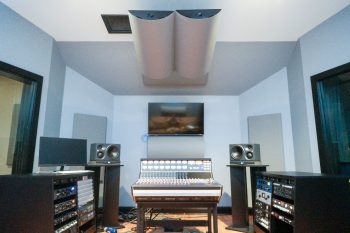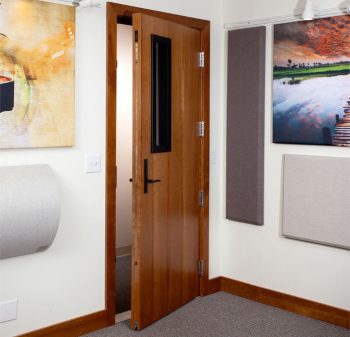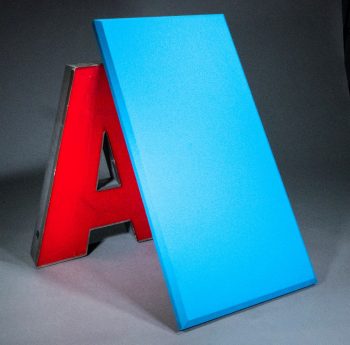How to Build a Podcast Studio: Podcast Buckets vs. Acoustical Treatments
Whether you’re thinking about creating one, or you’re already producing a podcast, you likely hope to cultivate and foster a loyal fan base. To do so, of course, your primary goal is to provide your audience with compelling content, but you also need to very seriously consider the quality of the sound you’re recording.
Listeners don’t want to strain to hear you over echoes, reverberation, or unwanted sounds intruding into your podcast station. Solutions such as soundproofing and acoustical room treatments will ensure that your listeners can focus on and enjoy the superior content you’re working so hard to present to them.
Let’s have a look at some professional studio treatments as well as how to build a podcast studio –– even when you’re on a budget.
Soundproofing vs. Acoustical Treatments
Before getting started, it’s important to clearly distinguish between soundproofing and acoustical treatments since many people often confuse or equate the two concepts.
Soundproofing blocks sound from entering or leaving a space by changing structural elements to acoustically isolate one space from another. This applies whether you’re trying to prevent noise from entering the building from outside or from other spaces within a building. You don’t want to hear outdoor traffic any more than you want to hear your kids romping and laughing in the background.
Acoustical room treatments, on the other hand, aim to improve sound quality within a given space by controlling the way sound is reflected, absorbed, or diffused by the interior surfaces. This creates the sonic environment in which your microphone “hears” all, and it is essential to creating an echo-free space in order to record conversation or musical performances with optimal fidelity.
For home-based podcasters, you can use “podcast buckets,” or you can treat the room with strategically placed acoustical panels.
What is a Podcast Bucket?
In an ideal world, you would record your podcast in a dedicated studio with soundproofing and acoustical treatments built right into the floor, ceiling, and walls – such as they are in high-end recording facilities.

Many podcasters, however, don’t enjoy this luxury. Often, an unused corner or room of the host’s home functions as their default “studio.” If this is you, you have two options for your room treatments.
A podcast bucket is a barrier of dense, sound-absorbing material built near and around your microphone on all sides except for the front that helps prevent any sound from bouncing back into the microphone. Depending on your budget, you can either buy one, or you can try to MacGyver your own by using a box lined with some sort of acoustically-absorbent material like cotton fiber or fiberglass.
Podcast buckets are an inexpensive—and hopefully temporary—solution for voice recording, and they work best when paired with a directional microphone. If you’re on a seriously limited budget, you may be able to achieve beginner-level sound quality with a podcast bucket, but ultimately, it will never be as good as true studio acoustical treatments.
Soundproofing Your Podcast Studio
True studio soundproofing requires architectural isolation by increasing the density and isolation of its interior surfaces. For the truly serious podcaster, this could go as far as de-coupling walls, floors, and ceilings. You can also double-up any of these surfaces and use a product like Green Glue in between them for added sound absorption. It helps to target and reduce the lower frequencies which are typically quite tough to isolate.
If budget is an issue, and you can’t undertake major structural changes, at least sealing gaps around door frames as well as electrical, light, and air duct openings will go a long way toward soundproofing your studio. Should you need have an interior window, installing soundproof interior windows will also help to ensure that no noise will leak in or out.
And for the ultimate in high-end studio quality, you can also install Studio 3D™ Soundproof Interior Doors. With STC ratings up to 56, they can be custom manufactured to any specifications.

Acoustically Treating Your Podcast Studio
Now that you’ve soundproofed your podcast studio, you’ll want to enhance the quality of the sound environment within it. It’s the hard, reflective surfaces of your walls, ceiling, and floor that will bounce sound around your studio like a thousand ball bearings in an empty coffee can – creating the dreaded echo and reverberation that you most want to eliminate.
In a pinch, some podcasters have worked with less-than-favorable compromises, such as hanging heavy moving blankets on walls and over windows. Improvised treatments of this nature, however, are nowhere near as effective as commercial treatments. If you’re hosting guests, these haphazard solutions not only look terrible, but you’ll also appear quite unprofessional. Of course you also run the risk of evoking the ire of a very unimpressed spouse or roommate.
Acoustical treatment options vary from room to room and from studio to studio, but the goal is always to control how sound is reflected, diffused, and/or absorbed, and this is a function of the dimensions, proportions, and layout of the space.

NOISE S.T.O.P. FABRISORB™ fabric-wrapped wall panels are high performance, affordable fiberglass sound absorbers that can easily be installed on nearly any wall surface and provide reduced echo and reverberation. They come in many color and size combinations and do a great job of taming overly-reflective rooms.
For a more in-depth acoustical treatment, you can incorporate sound diffusers. While you want to reduce reverberation, you can overdo it and end up with a totally “dead” sounding room, so you’ll want to maintain some amount of ambience to achieve a balanced, “real sounding” environment. Curve Diffusors™ serve to spread out sound energy, and they work best when you combine them with sound absorber panels.
For an innovative and environmentally sustainable alternative to traditional fiberglass and synthetic panels, CFAB Cellulose Sound Absorber Panels are very cost-effective and offer good performance at a low price. They control and deaden noise, reducing airborne sound transmission from flat-surface reflections. With a Class A Fire Rating, they’re easy to install, and they resist mold growth.
Finally, Sound Silencer™ acoustical sound panels are also Class A fire rated with STC and NRC ratings alike. They’re non-fibrous, and resistant to moisture, impact, fungi, and bacteria. These panels provide high-performance sound blocking and absorption, so they’re another fantastic option for you to consider.
Conclusion
Whether you’re designing a professional recording studio, or you simply want to improve the sound quality of your home-based podcast, knowing how to improve a room for voice recording will help you deliver your message to your listeners without unwanted audio distractions. Let them luxuriate in the mind-blowing content you’re working so hard to send their way, and hopefully, you’ll collect and keep fans and followers by the legion.



